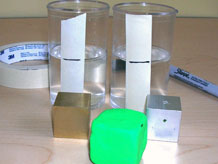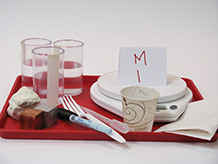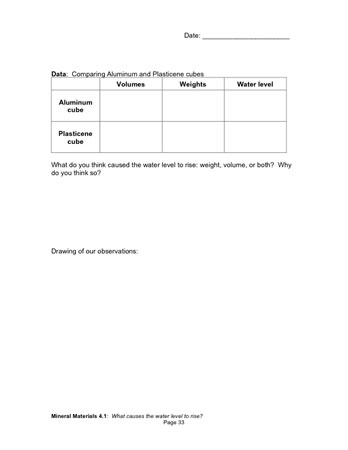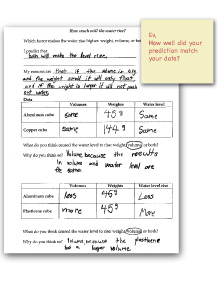What causes the water level to rise?
Plan Investigation 4.1

What makes the bathtub overflow when a person settles in for a bath? Is it weight or volume? It's the volume, but children often believe it is weight that "pushes the water out of the way." In this investigation, students confront this idea head on.
Today, students gather evidence to decide if weight or volume is the determining factor in the displacement of water.
Formative Assessment
Available online at inquiryproject.terc.edu
By the end of this investigation students will understand that objects submerged in water will always change the water level, and that it is volume, not weight, that determines how much water will be moved aside.
Learning Goals
- Discover what property of a sunken object makes the water rise
- Understand that two objects cannot occupy the same space at the same time
| Sequence of experiences | ||
|---|---|---|
| 1. Ask the question | All Class | 10 Mins |
| 2. Explore water displacement | Small Groups | 15 Mins |
| 3. Share data | All Class | 5 Mins |
| 4. Make meaning | Discussion | 15 Mins |
Materials and Preparation
For the class:
- Post the investigation question in a place where all students can see it.
- Prepare two class data charts, one for weight, another for volume; examples are shown in the notebooks and in Step 3.
Have the following materials ready for a demonstration at the start of class:

- 2 150cc containers with a vertical strip of masking tape applied to the outside, each approximately half full of water
- 2 rocks or minerals, one visibly larger than the other (each must fit in 150cc container)
- 1 aluminum cube (44g)
- 1 copper cube (147g)
- 1 44g cube of plastic modeling clay (same weight as aluminum cube)
- 1 3oz cup of water
- 1 pipette
- 1 plastic fork
- 1 fine tip permanent marker
- 1 paper towel
For each tray:

- 3 150cc containers with a vertical strip of masking tape applied to the outside, each approximately half full of water
- 1 aluminum cube
- 1 copper cube
- 1 piece of plastic modeling clay weighing approximately 50g
- 1 pipette
- 1 3oz cup of water
- 1 fork
- 1 fine tip permanent marker
- 2 paper towels
- 1 digital scale
Can students use evidence to reason that volume, not weight, determines how high the water level will rise?
Look for evidence in students’ notebook pages. As you interpret the notebook entries, remember that children typically think that heavier objects displace more water than lighter ones.
Does the student:
- Claim it’s volume and refer to evidence: (1) The aluminum and copper cubes had same volume and very different weights and water rose the same amount. (2) The two cubes with different volumes, made the water level rise different amounts.
- Claim it’s not weight and refer to evidence: (1) When the volumes were the same, the heavier cube did not make the water level rise more. (2) When the weights were the same but the volumes were different, the cube with the greater volume made the water level rise more.
As a next step, hold up a steel cube and a nylon cube and ask, “Which cube would make the water level rise more?”









